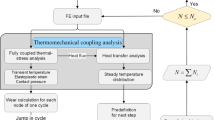Abstract
Injection moulded polymer-based components are important for cost effective and fast production/assembly of auxiliary mechanisms in automotive industry. Wear is one of the critical factors, which influences the reliability and useful life in such mechanical components. Experimental determination of life parameters in terms of wear has both a cost and time impact. Therefore, the ability to predict wear at the development stage enables the designers to come up with a better design, longer useful life and more reliable products. This paper presents a numerical simulation of wear for a polymer–polymer sliding surface contact in dry conditions. Finite element analysis (FEA) is used as a tool to calculate nodal pressures at the contact area for small sliding steps. These pressures are then inputted to a customized wear calculating routine. The routine uses averaged wear coefficients (wear rates) obtained from custom designed experiments. The FE contact geometry is modified after each sliding step to account for the contact height decay thus determining wear volume loss over usage time and predicting the worn geometry.
Similar content being viewed by others
References
Lydersen S, Rausand M (1987) A systematic approach to accelerated life testing. Reliab Eng 18(4):285–293, DOI 10.1016/0143-8174(87)90033-3
Sfantos GK, Aliabadi MH (2007) Total hip arthroplasty wear simulation using the boundary element method. J Biomech 40:378–389, Medline DOI 10.1016/j.jbiomech.2005.12.015
Zhang WM, Meng G (2006) Friction and wear study of the hemispherical rotor bushing in a variable capacitance micromotor. Microsyst Technol 12(4):283–292, DOI 10.1007/s00542-005–0064-0
Williams JA (2005) Wear and wear particles - Some fundamentals. Tribol Int 38(10):863–870, DOI 10.1016/j.triboint.2005.03.007
Zhang WM, Meng G (2006) Numerical simulation of sliding wear between the rotor bushing and ground plane in micromotors. Sens Actuators A: Phys 126(1):15–24, DOI 10.1016/j.sna.2005.08.004
Podra P, Andersson S (1999) Simulating sliding wear with finite element method. Tribol Int 32(2):71–81, DOI 10.1016/S0301-679X(99)00012-2
Rabinowicz E (1995) Friction and wear of materials. Wiley, New York
Hutchings IM (1992) Tribology: friction and wear of engineering material. Edward Arnold Publishers, London
Kim NH, Won D, Burris D, Holtkamp B, Gessel GR, Swanson P, Sawyer WG (2005) Finite element analysis and experiments of metal/metal wear in oscillatory contacts. Wear 258:1787–1793 DOI 10.1016/j.wear.2004.12.014
Meng HC, Ludema KC (1999) Wear models and predictive: their form and content. Wear 181–183:443–457, DOI 10.1016/0043-1648(95)90158-2
Ashraf MA, Najafabadi BS, Hsu HY (2006) Wear prediction: a methodical approach. In Research in interactive design, Springer, Paris
Ashraf MA, Najafabadi BS, Hsu HY (2006) Surface-surface contact wear prediction using FEA. In Research in interactive design, Springer, Paris
Ashraf MA, Najafabadi BS, Gol O, Sugumar D (2006) “Time-to-failure” prediction for a polymer–polymer swivelling joint. Int J Adv Manuf Technol. DOI 10.1007/s00170-007-1219-1
Hegadekatte V, Huber N, Kraft O (2005) Finite element-based simulation of dry sliding wear. Model Simul Mater Sci Eng 13(1):57–75, DOI 10.1088/0965-0393/13/1/005
Cantizano A, Carnicero A, Zavarise G (2002) Numerical simulation of wear-mechanism maps. Comput Mater Sci 25:54–60, DOI 10.1016/S0927-0256(02)00249-5
ANSYS user’s manual for version 10.0
Bayer RG (2002) Wear analysis for engineers. HNB Publishers, New York
Ashraf MA, Najafabadi BS, Gol O, Sugumar D (2007) Finite element analysis of a polymer-polymer sliding contact for Schallamach wave and wear. Key Eng Mater 348–349:633–636
Author information
Authors and Affiliations
Corresponding author
Rights and permissions
About this article
Cite this article
Azeem Ashraf, M., Sobhi-Najafabadi, B., Göl, Ö. et al. Numerical simulation of sliding wear for a polymer–polymer sliding contact in an automotive application. Int J Adv Manuf Technol 41, 1118–1129 (2009). https://doi.org/10.1007/s00170-008-1560-z
Received:
Accepted:
Published:
Issue Date:
DOI: https://doi.org/10.1007/s00170-008-1560-z




